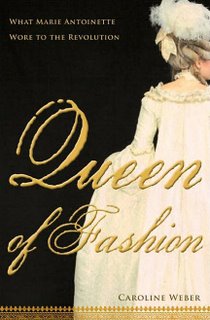New Revolutions, New Materials
 Ever since Antonia Fraser used her then-newly-forged family ties to reopen the case of Marie Antoinette, the spate of outpourings from Antoinettists has gathered speed. The latest to fall into my hot little hands was Caroline Weber's Queen of Fashion, subtitled "What Marie Antoinette Wore to the Revolution," a work whose underlying thesis seems to be that Clothes Really, Really, Really Matter. A plethora of carefully amassed and fascinating factoids and cartoons are assembled in a somewhat unfortunate substrate of contrived polemic, circuitous reasoning and tiresome repetition, just to make point after vacant point about the symbolic significance of the queen's wardrobe. Unfortunately, the effort also requires us misinterpret the lively, tongue-in-cheek French habit of adopting styles as badges and commentary, and to see it instead as being the very source and engine of change.
Ever since Antonia Fraser used her then-newly-forged family ties to reopen the case of Marie Antoinette, the spate of outpourings from Antoinettists has gathered speed. The latest to fall into my hot little hands was Caroline Weber's Queen of Fashion, subtitled "What Marie Antoinette Wore to the Revolution," a work whose underlying thesis seems to be that Clothes Really, Really, Really Matter. A plethora of carefully amassed and fascinating factoids and cartoons are assembled in a somewhat unfortunate substrate of contrived polemic, circuitous reasoning and tiresome repetition, just to make point after vacant point about the symbolic significance of the queen's wardrobe. Unfortunately, the effort also requires us misinterpret the lively, tongue-in-cheek French habit of adopting styles as badges and commentary, and to see it instead as being the very source and engine of change.I confess, though, that the little sight-bytes and juicy gossip were enough to make me carry on reading, in spite of my irritation with the basic misunderstanding that persuaded Ms. Weber to refer to the royal wardrobe as "clothing," "apparel," " fashion choices," and other such dreary substitutes, as if Marie Antoinette had been accustomed to doing battle and scoring points at Filene's.
Among other things, Ms. Weber is plain wrong about muslins coming from Rotterdam and Scotland-- they came from India, or rather, from Dacca, and everyone with well-heated houses all across Europe was wearing them. One only needs to read a bit between the lines to realize that this very young queen must have decided to have her coutur¡ère and assistants dress her, instead of all her aged and manipulative ladies in waiting, for no better reason than that a poisoned dress was not likely to be the instrument of her death in late 18th Century France. These were modern times, and my guess is that she took the position that all those biddies with hereditary charges to handle her person could start, accordingly, to mind their own business.
More than that, though, Ms. Weber nearly misses a huge slice of The Antoinette's contribution, which Antonia Fraser already covered both thoughtfully and well-- that is, her parallel effect on the future of interior design, where we feel her influence still. It was Marie Antoinette's idea that refinement, comfort and originality in private décor spelled chic, and that this could be achieved just as well by using printed cottons and lightly embroidered linens as silk brocades, velvets and tapestries, and through the use of painted finishes instead of gilding. I don't think she did this in a particularly Germanic way, although that is another curious thesis that persists.
 Springing back to the present on that note, Andrew Dent of Material Connexion gave a talk sponsored by Verandah Magazine at the D & D Building last week, about new materials for use in interiors. He explained that material science is but a distant contributor to the development of new materials. Instead, Dr. Dent demonstrated what Marie Antoinette must have known -- that it is the imaginative use of existing materials and technologies that yields products that can change the face and substance of interior design.
Springing back to the present on that note, Andrew Dent of Material Connexion gave a talk sponsored by Verandah Magazine at the D & D Building last week, about new materials for use in interiors. He explained that material science is but a distant contributor to the development of new materials. Instead, Dr. Dent demonstrated what Marie Antoinette must have known -- that it is the imaginative use of existing materials and technologies that yields products that can change the face and substance of interior design.The new transformations of substance are not, however, intuitive. Yellow Pages compressed with no glue at all can make something that looks remarkably like yellow Sienna marble, and that works, with the addition of a sealant, as resilient and sustainable synthetic flooring. Sustainability and clean air are key for these new product lines, and glues derived from soy are being used, not only because they are renewable but because they don't exude toxic fumes. Concrete can be made elastic through the use of embedded glass fibers. New kinds of bark cloth that look and feel like leather can be used for upholstery; a cork wallpaper that was passed around made me think that a noise-muffled room cloaked in this stuff could allow a crystal sconce or two to be hung on it without sacrificing too much.
 Fabrics synthesized from kernels of corn and bamboo are now made with safe glues. The new possibility of perpetual reuse of the same substance gives polyester a new and better name than before. Glass radiators are already a reality, instead of the scrap-generating metal ones we're used to. Wool makes fire retardant insulation. LED strips can safely backlight wood or onyx. Silver coated fabrics are anti-bacterial and therefore already being used in hospitals. Why not nurseries and car interiors?
Fabrics synthesized from kernels of corn and bamboo are now made with safe glues. The new possibility of perpetual reuse of the same substance gives polyester a new and better name than before. Glass radiators are already a reality, instead of the scrap-generating metal ones we're used to. Wool makes fire retardant insulation. LED strips can safely backlight wood or onyx. Silver coated fabrics are anti-bacterial and therefore already being used in hospitals. Why not nurseries and car interiors?Material Connexion , with offices in New York, Cologne, Bangkok and Milan, does not sell any of these materials, but advises clients on their use through an extensively catalogued library of renewable materials. Among adherents are Michele Oka Doner, Dror Benshetrit, Patagonia, Target and B & B Italia -- and who knows but the ghost of Marie Antionette.
Meanwhile, Ségolène Royal, another Woman in White, seems set to revolutionize
 French politics, pare down excesses of presidential pomp, and turn her country's attention to environmental issues. If what she wears really really matters, what she's wearing to this revolution will underscore the purity that she is said to embody, and which her rival Nicolas Sarkozy, whose personal life has known turmoil, seems to lack. In any event. whether it is because of her protectionist inclinations or other factors, she is already being compared to Jeanne d'Arc. Stranger still, however, the thought of a President of France called Madame Royal.
French politics, pare down excesses of presidential pomp, and turn her country's attention to environmental issues. If what she wears really really matters, what she's wearing to this revolution will underscore the purity that she is said to embody, and which her rival Nicolas Sarkozy, whose personal life has known turmoil, seems to lack. In any event. whether it is because of her protectionist inclinations or other factors, she is already being compared to Jeanne d'Arc. Stranger still, however, the thought of a President of France called Madame Royal.
<< Home